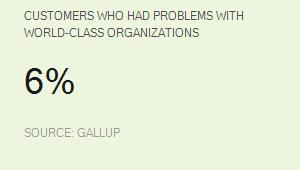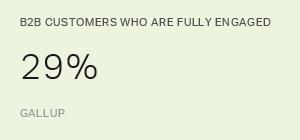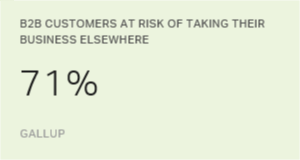Story Highlights
- B2Bs have more to lose than B2Cs when problems occur
- Reducing problems can mean a competitive advantage for B2Bs
- B2Bs need a unique approach to managing customer problems
In the business-to-consumer (B2C) realm, it's all too common to hear tales of customer service woes. Yet business-to-business (B2B) companies may stand to lose the most from service failures.
Though some might believe B2B customer relationships are easier to manage and less likely to have problems than B2C relationships, Gallup has found the opposite to be true. B2B companies have fewer customers, meaning that even the slightest misstep can have catastrophic consequences.
For example, when a customer encounters a problem in the B2C world, he may become disengaged and stop buying from that company. If that happens, the company will lose just one of its thousands or millions of customers; for a retail bank, it might be a savings account worth $5,000. But for a B2B supplier, losing one customer can result in a significant loss of income. In the case of a professional services company, a frustrated customer could take away a contract worth millions of dollars.
Gallup has seen B2B service problems up close. We recently worked with a manufacturer that had problems with its production process. The problems upset many of the manufacturer's customers because its deliveries were frequently late, which set off a costly chain of events. In one instance, a customer had ordered equipment and hired workers to install the product on the delivery date promised by the manufacturer. The customer didn't learn until that morning that the product wouldn't be arriving, but it still incurred costs for the equipment and the workers it had scheduled. To make matters worse, the customer had to pay for supplies and labor again when the product finally arrived.
With the Right Interventions, B2B Companies Can Minimize Problems
Though B2B suppliers have more to lose when problems occur, they also have more to gain. Gallup has found that problems occur less frequently over time among the B2B companies that are actively measuring and managing customer engagement. In particular, among world-class organizations -- those at the 90th percentile for controlling and reducing their problem incidence rate -- only 6% of customers encountered problems in 2015. This finding suggests that companies can minimize these problems with the right interventions.
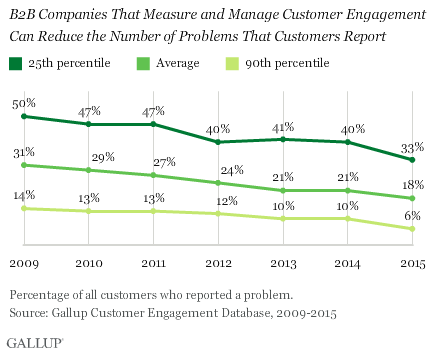
Though B2B companies in Gallup's database are having fewer problems than in past years, they have slightly more problems and more performance variance across business units than their B2C counterparts. B2B companies also have done a much poorer job of handling and resolving customer problems. This finding is particularly unfortunate because service failure destroys customer engagement, while service recovery can build engagement if it's handled properly. Not surprisingly, B2B customers are also less engaged than B2C customers.
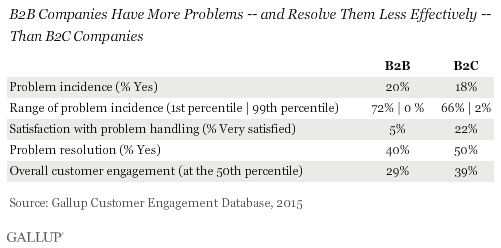
B2B suppliers have an opportunity to gain serious competitive advantage if they can reduce problem incidence and can get better at resolving and handling problems when they happen. For example, the manufacturer mentioned previously implemented two fixes to stop problems from occurring and to improve communication when problems happened:
- Employees who noticed a problem with on-time delivery thought they would be punished for pointing it out. To correct this, the manufacturer's leadership worked to create an organizational culture that rewarded and celebrated employees for bringing problems to light.
- The supplier also developed a system that alerted salespeople to problems with a customer account so they could communicate well in advance if a customer's delivery was going to be late. That way, the customer would have sufficient time to adjust its schedule and avoid incurring unnecessary costs.
The manufacturer salvaged its damaged relationship with its customers and strengthened its business by implementing this problem-handling strategy.
B2B Customers Require a Different Approach
B2C customers typically look for a product or service to fill a specific, immediate need in their lives. They are often the sole decision-makers and usually have a shorter timeline, smaller budgets and fewer customer service needs than B2B customers.
In contrast, B2B customers usually purchase a product or service for an entire division or company. They tend to be repeat buyers and often have a longer buying cycle and higher budgets than B2C customers. They also have higher expectations for individualized customer service, even when they can't clearly define what those expectations are.
B2B purchasing decisions are rarely made by one decision-maker; instead, decisions are usually made by a buying center that represents many different functional areas within a company. Creating and sustaining customer engagement -- and handling and resolving problems when they occur -- requires balancing the needs and wants of all members of the buying center -- from key decision-makers to the product's or service's users.
When problems occur, the best companies use them as opportunities to create or deepen customer engagement. Because of the unique nature of B2B customer relationships, the best B2B companies look carefully at their brand promise when considering the best way to handle customer problems, and they create a clearly defined strategy for resolving them before problems occur. This strategy includes:
Focusing on what matters most. B2B customers want the suppliers they do business with to be experts on them, their industry and their own customers. Gallup analysis has identified the key elements of a successful B2B relationship. When problems occur, the supplier can use these elements to consider the best way to handle and resolve problems and look for solutions to prevent them from occurring in the future. They include:
- having a clear understanding of a B2B customer's business and how problems affect the company and its customers, if they are affected too
- developing service-recovery solutions uniquely tailored to the customer's organizational culture
- knowing the customer's industry and its day-to-day work environment
- bringing a customer creative ideas to help it achieve its business goals and create positive outcomes for its customers
Treating B2B customers as partners. Because of the complexity of B2B customer relationships, problems may not always be the result of errors or a product or service failure. Instead, problems may stem from a lack of communication, misunderstandings or conflicting messages between the supplier and the members of the company's buying center, or among buying center members themselves. Because of this, suppliers should build strong relationships to facilitate timely and accurate communication. When product, service or communication failures occur, suppliers can draw on these partnerships when discussing and negotiating how to solve these problems.
Maintaining a focus on customers across all company functions. Few B2B customer problems can be resolved by a single contact person or the immediate account team. The problem usually requires close collaboration across customer support, product development, technology and other roles. When a problem occurs, the account team needs to quickly present the full picture to key executives and employees. Yet in many companies -- B2B suppliers included -- these functional teams operate in silos; they may have competing priorities and different understandings of the problem and how best to handle and resolve it. Effective and efficient problem resolution requires strong leadership from the account team and reward mechanisms that recognize employees for the outstanding ways they handle problems -- no matter what role they play in that process.
Including senior leaders in service recovery. Senior leaders can play a crucial role in organizing resources to design and implement a companywide service-recovery strategy and process, but one task may be the most important of all. Companies can create or maintain customer engagement when a problem occurs, but how they handle problems is more important to creating emotional engagement than simply resolving the customer's problem. Never underestimate the positive influence a senior leader's proactive and sincere apology can have. Senior leaders also need to "walk the walk" if they want to inspire all employees to maintain a focus on customers and go above and beyond to solve problems. Finally, senior leaders' sponsorship and empowerment of the account team is vital to ensuring customer engagement during service recovery -- no matter how capable the account team is.
Defining a people strategy. To successfully implement the service recovery strategy outlined previously, B2B suppliers must ensure that they have the right people in place. Though the supplier-customer partnership is a relationship between two companies, the supplier's employees are fundamentally responsible for building that partnership, and they ultimately solve or handle customer problems. Suppliers should select employees who take ownership of customers' problems, who have high empathy and care about customers' feelings and who put customers' interests before their own.
Employee engagement also matters. Gallup research shows that engaged employees are more active in learning and continually update their knowledge of and experience with problem resolution. These employees are more likely to work to break down silos among teams and to go the extra mile in handling problems in ways that exceed B2B customers' expectations.
